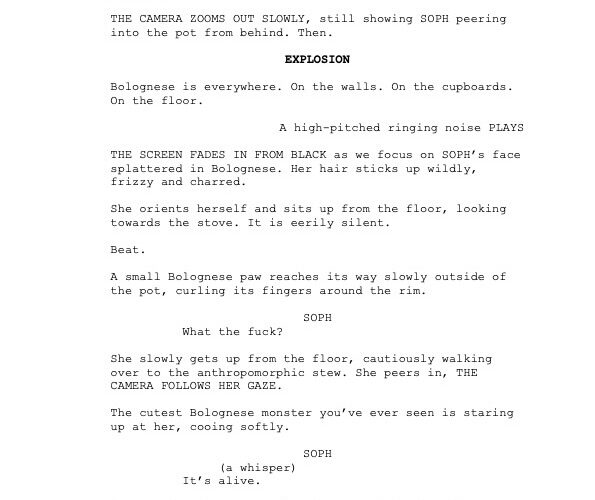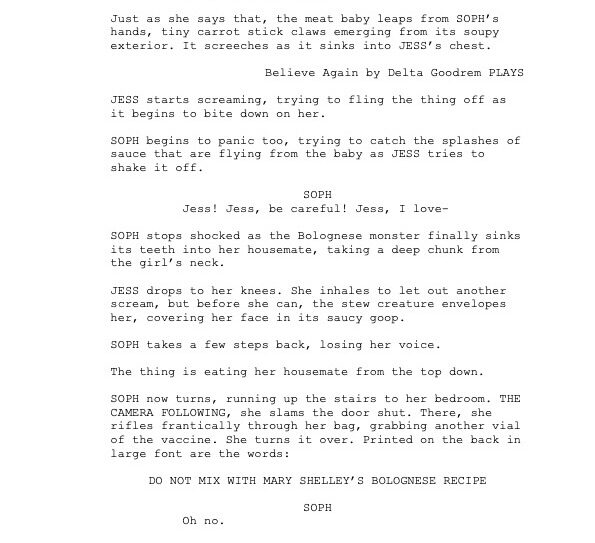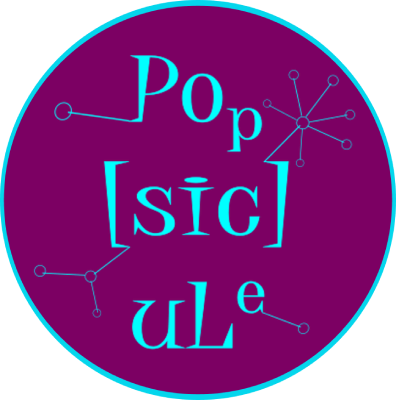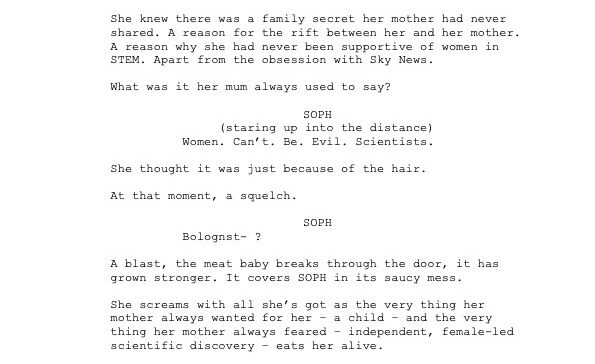
By ELLA MCLAUGHLIN – A ‘Science & Humour’ Project (SCOM2006, 2025)
Employing science fiction and fantasy as a framework for cinematic storytelling, I aim to uncover the effects humour has on challenging and dismantling the stereotypes of female scientists. Following the night of a young vaccinologist, Bolognstein entertains and engages an audience that is reflected, not in a mad scientist, but in a girl coming to terms with her choices and identity in modern society. Satirising subversive feminist tropes, I encourage a deeper discussion to be had on the role of women in science and the space they occupy.
The conception of the female mad scientist predates that of the male mad scientist[1], however, women’s role in the field of evil science is vastly behind that of their male counterparts. In The Dunciad (1728) by Alexander Pope, the mad scientist, Mathésis doesn’t invent a monster, she becomes one. By turning this madness inwards, traditional media allows women to be “dangerous sexually and morally, not intellectually.”[2] In Bolognstein, I subvert this belief by adding a comedic lens to the dogma of immaculate conception and at the same time, playing with the stigma of single mothers. Along with the thematics of vaccine misinformation, the everyday viewer begins to understand the tropes of female scientists and how they might not hold much evidentiary value. These challenges become only clearer with the utilisation of the incongruity theory to introduce an absurdist reality that coalesces the field of science fiction with critical social commentary. Can women have it all – the career and the family? Under the imagined science of creating life from Bolognese, the character of Soph amalgamates this choice into one, but in a heightened environment, is she being too selfish? This implication of cognitive estrangement[3], therefore, is best engaged with in settings such as movie theatres, streaming sites, and social media platforms, where young women can discover the comedy of science.
By highlighting the humour of irony in my science communication product, critical discussion surrounding scientific feminism is more causally accessible, allowing the audience to engage in this arena of absurdity. With a deeper understanding, women can learn new forms of science while looking out for the tropes that restrict them. The incongruity theory of horror combines to show the shock of possibilities open to female scientists when working in a hybrid-genre sphere – Can female scientists be evil? Can female scientists be mad? In Bolognstein, Soph sits in stark contrast to her mother, Mary Jr., highlighting how different choices can deeply inform our identity. This disparity does evoke the stereotypes of female scientists in Soph while equally playing into the pressures of settling down and motherhood. Although she has other strong relationships with women in her life, Mary Jr. is the manifestation of traditional values that Soph cannot separate herself from. These tropes underlie their family lineage, so to cook her grandmother’s Bolognese recipe, Soph must confront them. In opposition to these ideals, Soph’s grandmother had a long and successful career as a science fiction writer, where she often had to travel all over the world for work. By trying so hard not to be like her own mother, Mary Jr. had inadvertently repeated the same cycle, down to a rejection of the very science her daughter specialises in. Because of both women trying to be something they’re not, Soph accidentally does succeed in the amalgamation of science and motherhood with her mistaken creation, Bolognstein. But, this is a subversion of the science fiction framework, and when a male mad scientist brings something to life, it stereotypically turns out evil. Finally, Soph achieves what her mother had always wanted – the perfect dinner. Ironically, it was done the way her mother always hated – complete sacrifice for the sake of science.
In traditional science fiction, women can’t just be complex individuals with the capacity to make selfish decisions and mistakes – they have to become the anthropomorphic embodiment of madness, degraded to the trope of monster. Whether you choose to become a mother or a scientist, it must be with complete sacrifice. By creating a contemporary piece of science fiction that satirises these expectations, I aimed to make science more accessible to a larger audience and encourage more women to work in STEM. Absurdism challenges what is considered normal and science fiction factualises what is possible, when looking at this through a subversive feminist framework, all women are mad scientists.


[1] Jess Nevins, “From Alexander Pope to ‘Splice’: A Short History of the Female Mad Scientist,” Gizmodo, April 21, 2011, https://gizmodo.com/from-alexander-pope-to-splice-a-short-history-of-the-5794436.
[2] Jess Nevins, “From Alexander Pope to ‘Splice’: A Short History of the Female Mad Scientist,” Gizmodo, April 21, 2011, https://gizmodo.com/from-alexander-pope-to-splice-a-short-history-of-the-5794436.
[3] Gregory Renault, “Science Fiction as Cognitive Estrangement: Darko Suvin and the Marxist Critique of Mass Culture,” Discourse 2 (1980): 113–41, http://www.jstor.org/stable/41389056.



